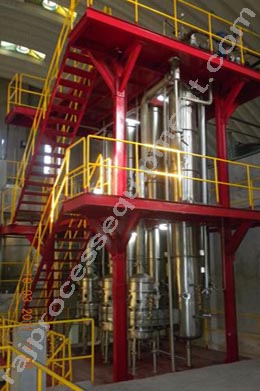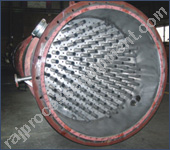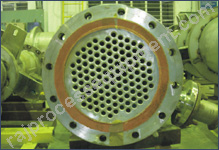Falling Film Evaporator Manufacturers in Pune

A falling film evaporator is a industrial device to concentrate solutions, especially with heat sensitive components.
Falling Film Evaporators are used to concentrate solutions, especially with heat-sensitive components. They have a crucial role to play in industries like food, desalination and refineries. Raj Process Equipment is the best among the Falling Film Evaporator manufacturers in Pune. Falling film evaporators give a faster response as compared to submerged and vertical tube evaporators.
In falling film evaporators the liquid product usually enters the evaporator at the head of the evaporator. The product is evenly distributed into the heating tubes. A thin film enters the heating tube and it flows downwards at boiling temperature and is partially evaporated. In most cases steam is used for heating the evaporator. The product and the vapor both flow downwards in a parallel flow. This gravity-induced downward movement is increasingly augmented by the co-current vapor flow. The separation of the concentrated product from its vapor is undergoing in the lower part of the heat exchanger and the separator.
Falling film evaporators can be operated with very low temperature differences between the heating media and the boiling liquid, and they also have very short product contact times, typically just a few seconds per pass. These characteristics make the falling film evaporator particularly suitable for heat-sensitive products, and it is today the most frequently used type of evaporator.
However, falling film evaporators must be designed very carefully for each operating condition; sufficient wetting (product film thickness) of the heating surface by liquid is extremely important for trouble-free operation of the plant. If the heating surfaces are not wetted sufficiently, dry patches and incrustations will occur; at worst, the heating tubes will be completely clogged. In critical cases the wetting rate can be increased by extending or dividing the evaporator effects, keeping the advantages of single pass (no recirculation of product) operation.
The proper design of the product distribution system in the head of the evaporator is critical to achieve full and even product wetting of the tubes.
Because of the low liquid holding volume in this type of unit, the falling film evaporator can be started up quickly and changed to cleaning mode or another product easily.
Falling film evaporators are highly responsive to alterations of parameters such as energy supply, vacuum, feed rate, concentrations, etc. When equipped with a well designed automatic control system they can produce a very consistent concentrated product.
The fact that falling film evaporators can be operated with small temperature differences makes it possible to use them in multiple effect configurations or with mechanical vapor compression systems in modern plants with very low energy consumption..
Features of the Raj Falling Film Evaporator
- They result in vapor with very little entrained liquid
- They provide high rates of heat transfer
- They require lower liquid circulation rates (smaller pumps)
- They are suitable for operation at low temperature differences.
Benefits of Falling Film Evaporator
- High Heat transfer coefficients
- Low-Pressure Drop
- High Evaporation Ratios
- Low vulnerability to fouling
- Suitable for operation under deep vacuum
- Smaller in size as compared to alternate methods
- Compact Design aids in reduced piping work thus reducing cost
Working Principle:
The process fluid to be vaporized is feed to the evaporator at the top of the tube sheet. A suitable distribution unit is necessary in order to achieve an even liquid distribution. It is paramount that for this process minimal wetting rate is achieved.
Application :
Falling film evaporators are used extensively in chemical process industry, food and paper industry. Due to the absence of static head effect caused by liquid column as in other types of evaporators, evaporation can take place at very small effective mean temperature differences. The temperature difference are typically between 3 - 8oC. This is significantly less than in other devices used for evaporation, e.g. forced reboilers or kettle evaporators, here the effective mean temperature difference is between 15
and 300C. The film heat transfer coefficients are in general high, and characterised by surface boiling.
The absence of hydrostatic head allows this type of evaporator to operate at very low absolute pressures.
Features of the Raj Falling Film Evaporator
- Food Industry
- Chemical Industry
- Petrochemical Industry
- Polymer Industry
- The industry which produces the products which require low fouling tendency
- Industry producing low viscous products
Product residence time can be very short, especially in one through operation. These characteristic of short retention time low operation pressure and small required effective mean temperature differences makes this type of evaporator particularly suitable for concentration of heat sensitive liquids. The absence of nucleate boiling under normal operation conditions, and low temperature differences also reduces possible fouling tendencies.
Raj Process Equipment has a decade of experience in delivering quality products and maintaining highest quality standards. If you are looking for a Falling Film Evaporator Manufacturers in Pune then you should go ahead and choose them as they are an ISO certified company with a global clientele. They possess in-depth knowledge to offer the best solution to your requirement.


Features
- Fully automatic system to ensure smooth and easy operation.
- Sterile construction of equipment to maintain high hygiene level.
- Energy Efficient.
- Optimal space requirement.
- Carefully selected material of constructions taking into account the product properties.
- Complete sanitary design with CIP system.
- PLC controlled SCADA operated system.
Services
- Turnkey Plants.
- Manufacturing & Supply of Equipments.
- Engineering and Supervision of Civil and Structural work.
- Process and Detailed Engineering.
- Project Management.
- Commissioning and Training.










